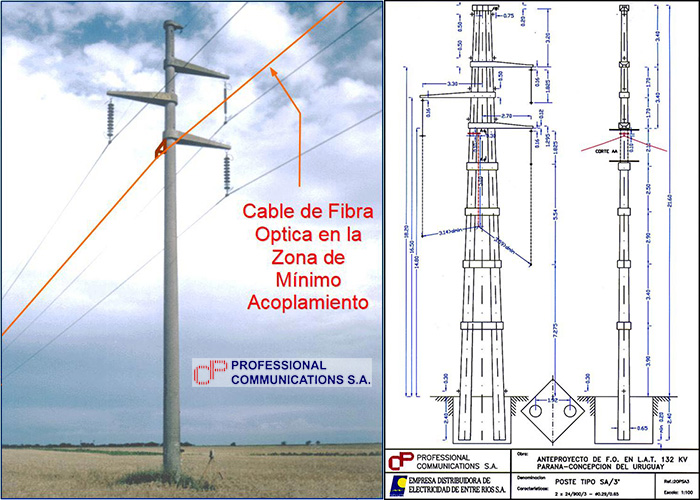Innovations
We present here our Research and Development (R&D) with details of some of the (R&D) Programs carried out; the R&D Project approved by the G.C.B.A. Authorities. (Res. No. 96 SDE-2001) carried out by PCSA; and our concepts of: Vision and Innovation, Change and Evolution, Strategic Planning and R&D Plan.
Research and Development (R&D) at PCSA
Some of the Research and Development (R&D) Programs carried out by PCSA are listed below :

Organizational Development
(EDEER S.A., Gas Natural BAN S.A., Telem. Arg, & Others)

ICT Structuring Integration
(EDEER S.A., Gas Natural BAN S.A., Telem. Arg, & Others)

ICT Structuring Integration
(EDEER S.A., Gas Natural BAN S.A., Telem. Arg, & Others)

Special Irradiating Systems
(EDEER S.A., Gas Natural BAN S.A., & Others)

Special Irradiating Systems
(EDEER S.A., Gas Natural BAN S.A., & Others)

Meteorological Risk Analysis
(EDEER S.A., CIEL S.A., & Others)

Optical Communications
(SIEMENS Arg. S.A.)

Aerospace and Defense Ind. Dev.
(CONAE y CITEFA)

A.M.S. of the Radioelectric Spectrum
(EDEER S.A., Gas Natural BAN S.A., Telem. Arg, & Others)

Organizational Development
(EDEER S.A., Gas Natural BAN S.A., Telem. Arg, & Others)

ICT Structuring Integration
(EDEER S.A., Gas Natural BAN S.A., Telem. Arg, & Others)

ICT Structuring Integration
(EDEER S.A., Gas Natural BAN S.A., Telem. Arg, & Others)

Special Irradiating Systems
(EDEER S.A., Gas Natural BAN S.A., & Others)

Special Irradiating Systems
(EDEER S.A., Gas Natural BAN S.A., & Others)

Meteorological Risk Analysis
(EDEER S.A., CIEL S.A., & Others)

Optical Communications
(SIEMENS Arg. S.A.)

Aerospace and Defense Ind. Dev.
(CONAE y CITEFA)

A.M.S. of the Radioelectric Spectrum
(EDEER S.A., Gas Natural BAN S.A., Telem. Arg, & Others)

Special Infrastructures
(EDEER S.A., Gas Natural BAN S.A., Telem. Arg, & Others)

Special Infrastructures
(EDEER S.A., Gas Natural BAN S.A., Telem. Arg, & Others)

Equipment for Automatic Measurements
(EDEER S.A., Gas Natural BAN S.A., Telem. Arg, & Others)

New Methodologies and Proprietary Software
(EDEER S.A., TGN S.A., Gas Natural BAN S.A., & Others)

New Methodologies and Proprietary Software
(EDEER S.A., TGN S.A., Gas Natural BAN S.A., & Others)

Marketing and Publicity
(Wide dissemination of PCSA locally and internationally)

Fiber Optic Communications Systems
(EDEER S.A., & Other Companies in Argentina & Abroad)

Fiber Optic Communications Systems
(EDEER S.A., & Other Companies in Argentina & Abroad)

Fiber Optic Communications Systems
(EDEER S.A., & Other Companies in Argentina & Abroad)

Special Infrastructures
(EDEER S.A., Gas Natural BAN S.A., Telem. Arg, & Others)

Special Infrastructures
(EDEER S.A., Gas Natural BAN S.A., Telem. Arg, & Others)

Equipment for Automatic Measurements
(EDEER S.A., Gas Natural BAN S.A., Telem. Arg, & Others)

New Methodologies and Proprietary Software
(EDEER S.A., TGN S.A., Gas Natural BAN S.A., & Others)

New Methodologies and Proprietary Software
(EDEER S.A., TGN S.A., Gas Natural BAN S.A., & Others)

Marketing and Publicity
(Wide dissemination of PCSA locally and internationally)

Fiber Optic Communications Systems
(EDEER S.A., & Other Companies in Argentina & Abroad)

Fiber Optic Communications Systems
(EDEER S.A., & Other Companies in Argentina & Abroad)

Fiber Optic Communications Systems
(EDEER S.A., & Other Companies in Argentina & Abroad)
- Improve the company’s ability to learn and respond to change;
- Ensure and maintain a high degree of quality of our products and services;
- Increase staff participation in the innovation process;
- Apply a continuous improvement methodology;
- Maintain the company in a competitive position and with differentiating attributes in the globalized world;
- Anticipate the problems of the company’s clients in order to implement new services and improve existing ones to allow their successful evolution;
- Increase the company’s penetration in both the local and international markets; and
- God willing, transcend through our inventions and works, making a contribution to the community.
For further details of the R&D Programs carried out by PCSA, see App. 8 of the "Background of PCSA" Report
![]()
R&D project approved by the G.C.B.A. Authorities (Res. Nº 96-SDE-2001, of 03-22-2001) carried out by PCSA
From mid-July to November 2000, PCSA carried out the following tasks:
- Elaboration of an innovative Research and Development project entitled “Technological Development of a New Method for the Installation of Optical Fibers and Other Means of Application in High Voltage Transmission Lines”. Compliance with the technical and formal aspects according to the Form Guides for the presentation of Idea-Project within the framework of National Law No. 23,877 Regime for the Promotion and Promotion of Technological Innovation;
- Presentation of the Idea-Project under Registry No. 410-DGCTALSDE-2000 to the Undersecretary of Industry, Commerce and Technology of the G.C.B.A. which he labeled as EXP. G.C.B.A. No. 72,720/2000 – Law 23,877; and
- Presentation of the PCSA Background Folder that included Commercial Summary, Commercial References, Certificates, Presentation of the new technology for installing fiber optic cables over LTAT, Complete patent documentation, Distinctions and References, and PCSA Corporate Presentation 2000 on CD -ROM, which was included in the EXP. G.C.B.A. No. 72,720/2000.

Photograph: From left to right, Eng. Patricio A. Sorichetti (PCSA), Eng. Eduardo Maddonni (Technology Directorate of the G.C.B.A.), Eng. Rubén C. Castaño (PCSA), Mg. Sc. Daniel Darío Caresani (Technology Director of the G.C.B.A.) and Dr. Héctor O. Alonso (Undersecretary of Industry, Technology and Foreign Trade of the G.C.B.A.), at the signing of the promotion contract between the G.C.B.A. and PCSA for the execution of the innovative Research and Development Project presented by PCSA, taken on Mar 22, 2001.
After analyzing the documentation presented by PCSA, indicated in the previous paragraph, the experts of the G.C.B.A. favorably evaluated the innovative Research and Development Project entitled “Technological Development of a New Method for the Installation of Optical Fibers and Other Means of Application in High Voltage Transmission Lines” (First PCSA technology, protected by US Patent No. 6,127,625, and Argentine Patent No. AR008368B1).


National Institute of Industrial Technology of the Argentine Republic (INTI) through the CITI which is the Center for Research in Telecommunications, Electronics and Informatics of the INTI system) carrying out the Technical Evaluation of the PCSA Project.
A rigorous technical evaluation of the project was carried out, evaluating:
a) Technology, b) Objectives, c) Work Plan, d) Schedule, e) Cost of the project, f) Risk Indicators, g) Project success indicators, h) Background of the company, i) Equipment with which account the company, j) Curriculum of the professionals responsible for the project, k) Human Resources: Suitability and capacity of the work team that will carry out the project, and l) Technical risk of the project.
Likewise, several inspection visits were carried out to verify and check the company’s background, the background of the professionals and the equipment with which the project will be carried out.
Evaluation result: “From a technical point of view, it is suggested to approve the project presented by Professional Communications S.A.”.
Integral Study of Foreign Trade (EICE) the realization of the Economic Evaluation of the Project presented by PCSA
A rigorous economic evaluation of the project was carried out, evaluating:
a) Sector of the company and the project, b) Potential market that it will face, c) Social benefit, d) Planning of the company and the project so that the initiative is profitable, and e) Economic feasibility of the project.
Likewise, several inspection visits were carried out to verify and check the company’s background, the background of the professionals and the accounting and financial statements of the company.
Evaluation result: “The project comfortably has all the characteristics and economic conditions necessary to access what is requested”.

The Consultative Council of the City of Buenos Aires favorably recommended the project presented by PCSA according to the Minutes of its 32nd Ordinary Meeting.
On March 22, 2001, the Economic Development Secretariat of the Government of the Autonomous City of Buenos Aires (G.C.B.A.) within the framework of Law 23877 for the promotion of technological innovation, has approved by Resolution No. 96 the Research and Development project of an innovative nature presented by PCSA (GCBA File No. 72720/2000) (First PCSA patent).

The entire project was technically audited by the National Institute of Industrial Technology of the Argentine Republic (INTI), through CITI; and economically by the Integral Study of Foreign Trade (EICE).
The project was completed, carrying out all the activities planned for each stage in a timely manner, and passing the final evaluation of each of them, to the complete satisfaction of the Enforcement Authorities of the Government of the Autonomous City of Buenos Aires.
It is worth noting that the project was widely publicized by the authorities of the G.C.B.A. and that it incorporated into its portal a summary of the same website: http://www.buenosaires.gov.ar/areas/produccion/tecnologia/creditos_tasa_0_empresas.php?menu_id=9004#a4.
Vision and Innovation at PCSA
The company’s strategic planning was based on a holistic and strategic study of the consulting sector carried out by its interdisciplinary team of professionals.
The study was based on a global logistics analysis using the scenario planning methodology. Its results include the following:
- Company Mission: find innovative solutions for its Clients that allow generating value more efficiently, promoting competitive and sustainable growth in the different possible futures.
- Strategic Plan: developed to fulfill the company’s mission. It takes into account, among other factors, the profound transformations and global trends originating from technological advances and the overcoming of exhausted structures, which lead to knowledge and information becoming the new key factors of power.
Consequently, a comprehensive consultancy should not be limited to advising its clients, but must be an entity that generates technology.
The company periodically carries out a self-analysis process to diagnose its evolution and objectively answer the question: Where is Professional Communications S.A. today?
From this, strategic thinking is stimulated, moving away from linear and traditional thinking, with the following objectives, among others:
- Break down the conceptual barriers that impede growth.
- Strengthen its differentiating aspects.
- Renew the holistic vision.
- Prepare responses for inevitable changes as well as unexpected twists and turns.
- Develop strategies that allow Clients to face their challenges and problems.
- Offer different alternatives to Clients that are well supported, effective and sustainable.
- Present a decision matrix that allows Clients a free and informed choice.
Change and Evolution in PCSA
Evolution is clearly necessary for growth. Although it is sometimes perceived as a threat, it must be understood as an opportunity.
It is often believed that change is less urgent than it really is and time is an important factor in determining who really adapts to change. The change is not an end in itself, but must be in accordance with the Strategic Planning.
In addition, since by its nature it always affects interests, resistance to change instinctively appears, from which there is always something to learn.
On the other hand, the groups that carry out the process of change (agents of change) must act consistent with the interests of the entity, and not at the service of other interests, their own or others.
The commitment of change agents to a strategy explicitly linked to actual objectives and performance will help spread the spirit of change throughout the entity and achieve the desired objectives.
Strategic Planning and Research and Research and Development Plan
It is a source of coherence, and through it, entities define where to go, how to get there, how to take advantage of opportunities and do it on time.
Within the framework of corporate objectives and strategic planning, the Research and Development (R&D) Plan of Professional Communications S.A. determines the guidelines for the development of innovation as the axis of the Company’s evolution. This is one of the differentiating aspects that allow the Company to provide a better service to its Clients.

